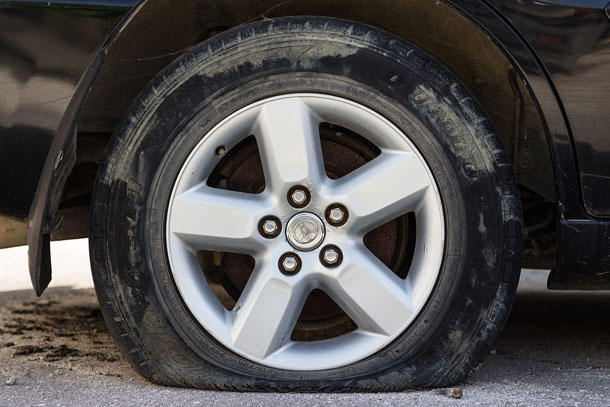DEALING WITH A FLAT TIRE
Dread it. Run from it. Destiny arrives all the same.
The idea of dealing with a flat tire is a major anxiety trigger for Ontario drivers.
According to a 2014 Hankook Tire poll 85% of Canadians would rather give a speech at work than deal with a flat tire.

HOW TO REDUCE YOUR CHANCES OF GETTING A FLAT TIRE
With millions of tires being punctured every year, there may be no escaping it but there are ways to better your odds.
- Ensure proper tire pressure.
This is especially true in the cold winter months when tires lose their air pressure easier. Learn how to check your tire pressure.
- Rotate tires regularly.
This will avoid uneven wear and tear of your tires which will help extend their life. Depending on your vehicle you should be rotating them every 8K – 15K kms.
- Avoid hazards.
This includes obvious things like visible pot holes. You should also try to avoid industrial areas and construction sites since this is normally where you’ll find more tire puncturing hazards on the ground like nails and scraps.
- Keep your vehicle load light.
The same place that tells you the proper tire pressure will show you the max weight they should be holding. If you must carry a heavy load at times, make sure your tire pressure is a little higher than it normally is to accommodate the extra weight.
Even if you do everything right you can still get a flat so it’s important to make sure your vehicle has a spare tire available, something that roughly 1/3 of modern vehicles do not have standard, and that you practice changing a flat tire.
WHAT TO DO WHEN YOU HAVE A FLAT TIRE
If you’re one of the 60% of people who don’t know how to change a flat tire then your best bet is to get to safety and call for help.
Pull over to the side of the road and turn your hazard lights on. Pull off far enough that you’re out of the way of oncoming traffic but not so far to the point where you’re difficult to find by a service vehicle.
Stay in your vehicle and call roadside assistance for help. This could be CAA, some other program you may be a part of through your dealership or just a tow truck company.
Get your tire repaired by a professional as soon as possible. If the spare tire is not the same quality or brand as the others you do not want to drive on it longer than you need to.
DRIVING ON A FLAT TIRE
Don’t!
Other than the couple hundred yards it takes to get safety off the road after a tire puncture you should never drive on a flat tire.
Doing so can cause serious harm to the rest of your vehicle and it’s dangerous due to reduced vehicle control.
Calling for a tow instead of trying to drive home with a flat tire seems annoying but it can help save your car or even your life.
HOW MUCH DOES IT COST TO REPAIR A TIRE?
You’re usually looking at around $20-$50 for service in a tire repair shop but this depends on the type and size of puncture and the tire itself.
Rectangle Auto Supply proudly offers quality used auto parts and used tires all over southern Ontario including St. Catharines, Thorold, Lincoln, Niagara on the Lake, Welland, Fort Erie, Port Colborne, Grimsby, Pelham, Hamilton (and more).
SOURCES:
1 - Tirereview.com
2 - Lesschwab.com
3 - Cheapcarinsurance.net
4 - CAA
Help keep our roads safe by sharing this page:
|

